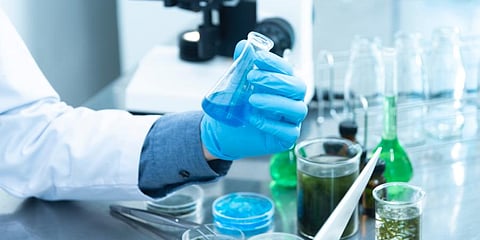

Chemical techniques in India can be traced back all the way to the Indus valley or Harappan civilisation (3rd millennium BCE). Following Acharya Prafulla Chandra Ray (1861-1944), the eminent Indian chemist of the last century and a historian of chemistry, five stages in its development in India can be recognised. They are: (i) the pre-Vedic stage upto 1500 BCE, including the Harappan period, (ii) the Vedic and the Ayurvedic period upto 700 CE, (iii) the transitional period from 700 CE to 1100 CE, (iv) the Tantric period from 700 CE to 1300 CE, and (v) the ‘Iatro-Chemical period’ from 1300 CE to 1600 CE. The dates cannot be considered definitive.
Metallurgy was intimately linked with chemistry in India. We will discuss Indian metallurgy and metal-working in a later article, focussing our attention on chemical techniques for now. Pre-Harappan Indians were acquainted with the art of making baked or burnt clay pottery as well as painting the same with two or more colours. This implies the construction of open and closed kilns. The pottery of the Harappan culture consisted of mainly wheel-made ware, turned in various shapes, sizes and colours out of the well-levigated alluvium of the Indus.
The colour and other characteristics of the wares depended upon the composition of the clay used and techniques of firing under either oxidising or reducing conditions. The Harappans also experimented with various mortars and cements made of burnt limestone, gypsum and mica, among other components. Finely crushed quartz, once fired, produced faience, a synthetic material; it was then coated with silica (perhaps fused with soda), to which copper oxide was added to give it a shiny turquoise glaze. Faience was then shaped into various ornaments and figurines.
Addition of iron oxide, manganese oxide, etc., resulted in different colours. The Harappan artisans must have had an intimate knowledge of the processing and properties of several naturally occurring chemical substances. The craftsmen were highly skilled in the art of shaping and polishing the precious and semi-precious stones used for the production of beads. In the second stage, Rigveda (earlier than 1500 BCE) mentions many fermented drinks and methods of fermentation, apart from various metals. Soma juice from the stems of the soma plant was highly extolled and considered a divine drink. Madhu and suraa (brewed from barley grain) also find mention.
Curd or fermented milk was an important food item. Cloths were mainly made of wool and the garments were often dyed red, purple or brown. Obviously, the Vedic Indians were acquainted with the art of dyeing with certain natural vegetable colouring matters. A type of pottery, now known as ‘Painted Grey Ware’, is associated with the Vedic period. This ceramic is a thin gray deluxe ware, mostly wheel-made, well-burnt, glossy and copiously painted. Later, ‘Northern Black Polished Ware’ also came into being in the eastern part of the Gangetic plains. Also, plenty of iron objects of the later period have been found throughout India.
Glass beads dating back to the 10th century BCE have been discovered. In the succeeding centuries, the glass industry gained momentum and there were notable feats of excellence, as evidenced by the archeological finds in over 30 sites spread over India. The sites include Taxila in present Pakistan, Hastinapur, Ahichchhatra and Kopia in Uttar Pradesh, Nalanda in Bihar, Ujjain in Madhya Pradesh, Nasik and Nevasa in Maharashtra, Brahmagiri in Karnataka, and Arikamedu in Puducherry. The glass objects include beads of different colours, including gold foil ones, glass vessels in green and blue colours, flasks of agate-banded type, bangles, ear-reels, eye-beads, etc.
There is no doubt that the glassmakers were skilful in controlling the temperature of fusion, moulding, annealing, blotching and gold foiling. The chemical composition of a typical glass specimen from Kopia is as follows: silica 66.6%, alumina 7%, alkalies (Na2O) 21.7%, ferric oxide 1.6%, lime 2.4%, manganese oxide .07%, and traces of titania and magnesia. Kautilya’s Arthashaastra (3rd or 4th century BCE), a well-known text of governance and administration, has a lot of information on prevailing chemical practices. Apart from mines and minerals, it discusses the details of precious stones (pearl, ruby, beryl, etc.), and also of the preparation of fermented juices (sugarcane, jaggery, honey, jambu, jackfruit, mango, etc.) and oil extraction.
It also has classifications such as sour fruit juices, liquids, spices, vegetables, etc., based on their chemical practices. The earliest versions of the two great Ayurveda classics, Charaka Samhitaa and Sushruta Samhitaa, may date back to a few centuries before the common era. They give accounts of several minerals, metals, metallic compounds, salts and fermented beverages. More importantly, they discuss the preparation of various alkalis (kshaara). Alkalis are of three types: mild (mridu), caustic (teekshna) and average (madhyama).
They are prepared from some 25 plants that are mentioned in Sushruta Samhitaa. Hot alkaline solutions were used for treating thin sheets of metals like iron, gold or silver before incorporation into drugs. Caustic alkalis were also used for treating surgical instruments. Varahamihira’s Brihat-samhitaa (6th century CE) gives detailed information on the preparation of various perfumes and cosmetics. It also gives recipes for the preparation of glutinous material to be applied on the roofs and walls of buildings.
M S Sriram (sriram.physics@gmail.com)
Theoretical Physicist & President, Prof. K.V. Sarma Research Foundation